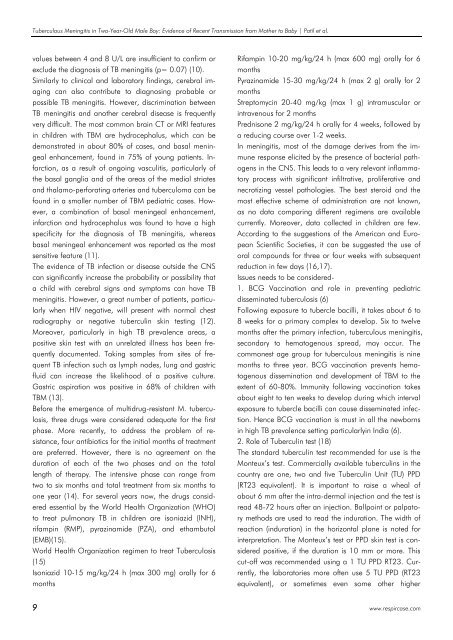Respircase Cilt: 6 - Sayı: 1 Yıl: 2017
You also want an ePaper? Increase the reach of your titles
YUMPU automatically turns print PDFs into web optimized ePapers that Google loves.
Tuberculous Meningitis in Two-Year-Old Male Boy: Evidence of Recent Transmission from Mother to Baby | Patil et al.<br />
values between 4 and 8 U/L are insufficient to confirm or<br />
exclude the diagnosis of TB meningitis (p= 0.07) (10).<br />
Similarly to clinical and laboratory findings, cerebral imaging<br />
can also contribute to diagnosing probable or<br />
possible TB meningitis. However, discrimination between<br />
TB meningitis and another cerebral disease is frequently<br />
very difficult. The most common brain CT or MRI features<br />
in children with TBM are hydrocephalus, which can be<br />
demonstrated in about 80% of cases, and basal meningeal<br />
enhancement, found in 75% of young patients. Infarction,<br />
as a result of ongoing vasculitis, particularly of<br />
the basal ganglia and of the areas of the medial striates<br />
and thalamo-perforating arteries and tuberculoma can be<br />
found in a smaller number of TBM pediatric cases. However,<br />
a combination of basal meningeal enhancement,<br />
infarction and hydrocephalus was found to have a high<br />
specificity for the diagnosis of TB meningitis, whereas<br />
basal meningeal enhancement was reported as the most<br />
sensitive feature (11).<br />
The evidence of TB infection or disease outside the CNS<br />
can significantly increase the probability or possibility that<br />
a child with cerebral signs and symptoms can have TB<br />
meningitis. However, a great number of patients, particularly<br />
when HIV negative, will present with normal chest<br />
radiography or negative tuberculin skin testing (12).<br />
Moreover, particularly in high TB prevalence areas, a<br />
positive skin test with an unrelated illness has been frequently<br />
documented. Taking samples from sites of frequent<br />
TB infection such as lymph nodes, lung and gastric<br />
fluid can increase the likelihood of a positive culture.<br />
Gastric aspiration was positive in 68% of children with<br />
TBM (13).<br />
Before the emergence of multidrug-resistant M. tuberculosis,<br />
three drugs were considered adequate for the first<br />
phase. More recently, to address the problem of resistance,<br />
four antibiotics for the initial months of treatment<br />
are preferred. However, there is no agreement on the<br />
duration of each of the two phases and on the total<br />
length of therapy. The intensive phase can range from<br />
two to six months and total treatment from six months to<br />
one year (14). For several years now, the drugs considered<br />
essential by the World Health Organization (WHO)<br />
to treat pulmonary TB in children are isoniazid (INH),<br />
rifampin (RMP), pyrazinamide (PZA), and ethambutol<br />
(EMB)(15).<br />
World Health Organization regimen to treat Tuberculosis<br />
(15)<br />
Isoniazid 10-15 mg/kg/24 h (max 300 mg) orally for 6<br />
months<br />
Rifampin 10-20 mg/kg/24 h (max 600 mg) orally for 6<br />
months<br />
Pyrazinamide 15-30 mg/kg/24 h (max 2 g) orally for 2<br />
months<br />
Streptomycin 20-40 mg/kg (max 1 g) intramuscular or<br />
intravenous for 2 months<br />
Prednisone 2 mg/kg/24 h orally for 4 weeks, followed by<br />
a reducing course over 1-2 weeks.<br />
In meningitis, most of the damage derives from the immune<br />
response elicited by the presence of bacterial pathogens<br />
in the CNS. This leads to a very relevant inflammatory<br />
process with significant infiltrative, proliferative and<br />
necrotizing vessel pathologies. The best steroid and the<br />
most effective scheme of administration are not known,<br />
as no data comparing different regimens are available<br />
currently. Moreover, data collected in children are few.<br />
According to the suggestions of the American and European<br />
Scientific Societies, it can be suggested the use of<br />
oral compounds for three or four weeks with subsequent<br />
reduction in few days (16,17).<br />
Issues needs to be considered-<br />
1. BCG Vaccination and role in preventing pediatric<br />
disseminated tuberculosis (6)<br />
Following exposure to tubercle bacilli, it takes about 6 to<br />
8 weeks for a primary complex to develop. Six to twelve<br />
months after the primary infection, tuberculous meningitis,<br />
secondary to hematogenous spread, may occur. The<br />
commonest age group for tuberculous meningitis is nine<br />
months to three year. BCG vaccination prevents hematogenous<br />
dissemination and development of TBM to the<br />
extent of 60-80%. Immunity following vaccination takes<br />
about eight to ten weeks to develop during which interval<br />
exposure to tubercle bacilli can cause disseminated infection.<br />
Hence BCG vaccination is must in all the newborns<br />
in high TB prevalence setting particularlyin India (6).<br />
2. Role of Tuberculin test (18)<br />
The standard tuberculin test recommended for use is the<br />
Monteux’s test. Commercially available tuberculins in the<br />
country are one, two and five Tuberculin Unit (TU) PPD<br />
(RT23 equivalent). It is important to raise a wheal of<br />
about 6 mm after the intra-dermal injection and the test is<br />
read 48-72 hours after an injection. Ballpoint or palpatory<br />
methods are used to read the induration. The width of<br />
reaction (induration) in the horizontal plane is noted for<br />
interpretation. The Monteux’s test or PPD skin test is considered<br />
positive, if the duration is 10 mm or more. This<br />
cut-off was recommended using a 1 TU PPD RT23. Currently,<br />
the laboratories more often use 5 TU PPD (RT23<br />
equivalent), or sometimes even some other higher<br />
9 www.respircase.com

















